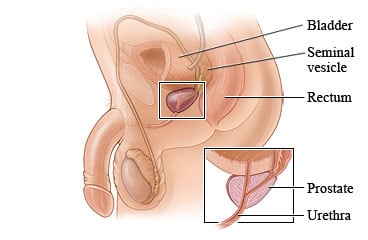What is transurethral resection of the prostate (TURP)?

Transurethral resection of the prostate (TURP) is surgery to remove some prostate tissue. It is done when an overgrown prostate gland is pressing on the urethra and making it hard to urinate.
The prostate gland is a small organ just below the bladder. It makes most of the fluid in semen. The urethra is the tube that carries urine from the bladder out of the body through the penis. It passes through the prostate. When the prostate gets too large, it can press on the urethra.
TURP is done to take pressure off of the urethra. It can help you have better control over starting and stopping your urine stream. You may feel like you get more relief when you urinate.
How is the surgery done?
Your doctor will give you medicine to make you sleep or feel relaxed. You will be kept comfortable. If you are awake during the surgery, you will get medicine to numb you from the chest down.
The doctor will put a thin, lighted tube, which is called a scope, into your urethra through the opening in your penis. Then the doctor will put small surgical tools or a tiny laser through the scope. The doctor will then cut or burn away the section of the prostate that is blocking urine flow. When the surgery is finished, the doctor will take out the scope.
What can you expect after the surgery?
You may stay in the hospital for 1 to 2 days after the surgery. You may be able to go back to work and do many of your usual activities in 1 to 3 weeks. But it is important to avoid heavy lifting or strenuous activities for about 6 weeks.
If your surgery was done with a laser, you may feel better faster. Most people go home on the day of laser surgery, then see their doctor soon after. You may be able to go back to work and your usual activities after a few days. And you may be able to return to strenuous activity and heavy lifting after about 2 weeks. But talk to your doctor first.
You may need a urinary catheter for a short time. This is a flexible plastic tube used to drain urine from your bladder when you can't urinate on your own. If it is still in place when you go home, your doctor will give you instructions for how to care for it.
You may still feel like you need to urinate often in the weeks after your surgery. It often takes up to 6 weeks for this to get better.
After they recover from surgery, most people still can have erections (if they were able to have them before surgery). But they may not ejaculate when they have an orgasm. Semen may go into the bladder instead of out through the penis. This is called retrograde ejaculation. It does not hurt and is not harmful to your health. But it may mean that you will not be able to have biological children. If this is a concern, talk to your doctor. You may be able to save your sperm before the surgery.
Follow-up care is a key part of your treatment and safety. Be sure to make and go to all appointments, and call your doctor if you are having problems. It's also a good idea to know your test results and keep a list of the medicines you take.
Where can you learn more?
Go to http://www.healthwise.net/patientEd
Enter N024 in the search box to learn more about "Learning About Transurethral Resection of the Prostate (TURP)".
Current as of: April 9, 2025
Author: Ignite Healthwise, LLC Staff
Clinical Review Board
All Ignite Healthwise, LLC education is reviewed by a team that includes physicians, nurses, advanced practitioners, registered dieticians, and other healthcare professionals.

